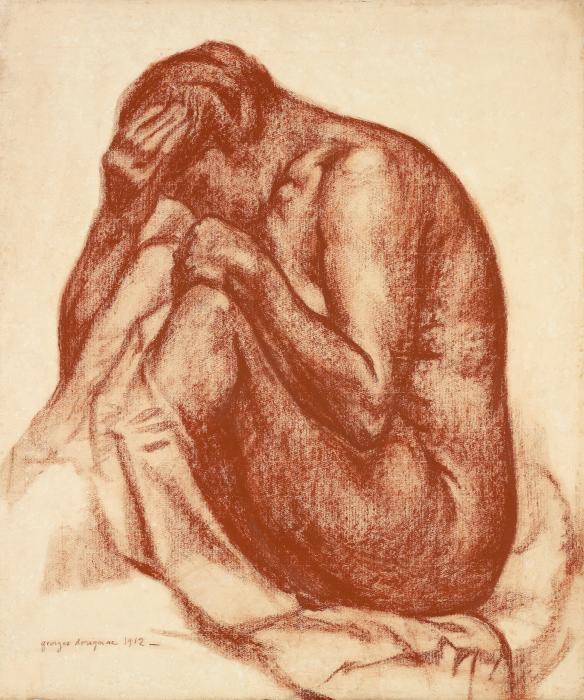Georges Dorignac
Seated Woman in Profile 1912
Red Chalk
Signed and dated (in the bottom left): georges dorignac 1912
56 x 47 cm
Provenance
- Paris, the artist’s studio
- By descent
Bibliography
- 2016 PARIS : Georges Dorignac, dessins rouges et noirs, catalogue d’exposition, Galerie Malaquais, Paris, 31 mars – 21 mai 2016, repr. p.16 n°5.
- 2016 MANSENCAL : Mansencal, Marie-Claire, Georges Dorignac, le maître des figures noires, Le Passage, Paris, 2016.
- 2016 ROUBAIX-BORDEAUX : Georges Dorignac (1879-1925), le trait sculpté, catalogue d’exposition, Roubaix, La Piscine – musée d’art et d’industrie André Diligent, 19 novembre 2016 – 5 mars 2017, Bordeaux, musée des Beaux-Arts, 18 mai – 17 septembre 2017, repr. p.140 n°44.
- 2019 PARIS : Dorignac, corps & âmes, catalogue d’exposition, Paris, musée de Montmartre, jardins Renoir, 15 mars – 8 septembre 2019.
Exhibitions
- 2016 PARIS : Georges Dorignac, dessins rouges et noirs, Galerie Malaquais, Paris, 31 mars – 21 mai 2016, n°5.
- 2019 PARIS : Dorignac, corps & âmes, catalogue d’exposition, Paris, musée de Montmartre, jardins Renoir, 15 mars – 8 septembre 2019.
Between 1911 and 1914, Dorignac abandoned his earlier experiments in color to concentrate on drawing. He produced works in red chalk and in a mixed technique incorporating deep blacks that featured female nudes, such as Seated Woman in Profile, as well as portraits or workers and peasants. At the Salon des Indépendants and the Salon d’Automne, his vigorously worked, “sculptural,” pieces caught the attention of critics, notably Guillaume Apollinaire, André Salmon, and Raymond Bouyer.
At this time, Dorignac was living in Montparnasse at La Ruche with his wife, Céline, and their four daughters; all frequently posed for him. The model for this Seated Woman in Profile, huddled over into a solid, compact form is, undoubtedly, Céline. The model’s legs are folded up against her breasts, with her arms encircling them, while her head is bent down toward her knees. Her monolithic form is tightly positioned within the rectangle of the paper. Rodin once said that “Dorignac sculpts his drawings (…).”[1] The figure of the Seated Woman in Profile could just as well have been modeled from a block of red clay.
There are many other drawings by Dorignac that feature female nudes folded in on themselves, as if forming a block, such as the superlative drawing that the FNAC acquired from the artist in 1916, which is currently on loan to the Grenoble museum (Inv. : FNAC 5453), the Nude held in the national museum of modern art (inv. : LUX.0.271D), and the Crouching Woman (Céline) in the Beaux-Arts museum in Bordeaux (Inv. : Bx 1999.1.1).
At the same time, another artist with a similar background, also from Bordeaux and living in Paris, was drawing female nudes, at times in red chalk, that show a strong affinity with Dorignac’s works; her name was Jane Poupelet. According to Dorignac’s granddaughter, Danielle Damboise, her grandfather knew and admired Jane Poupelet’s work. And in fact, her large red chalk drawing, Nu féminin de dos (Female Nude from the Back), also presents the body in a tight frame and in a “sculpted” style produced by the play of darker and lighter patches against areas of paper left empty, creating lighter zones. We find this technique similar to that of Seated Woman in Profile.
A number of Dorignac’s large black and red drawings are held in French and American public collections, but very few are such masterful female nudes as this one.
[1] The comment was recorded by Gaston Meunier du Houssoy in his “Essay on Dorignac,” letter to Jean-Gabriel Lemoine, November 16, 1955 (archives of the Beaux-Arts museum in Bordeaux).
